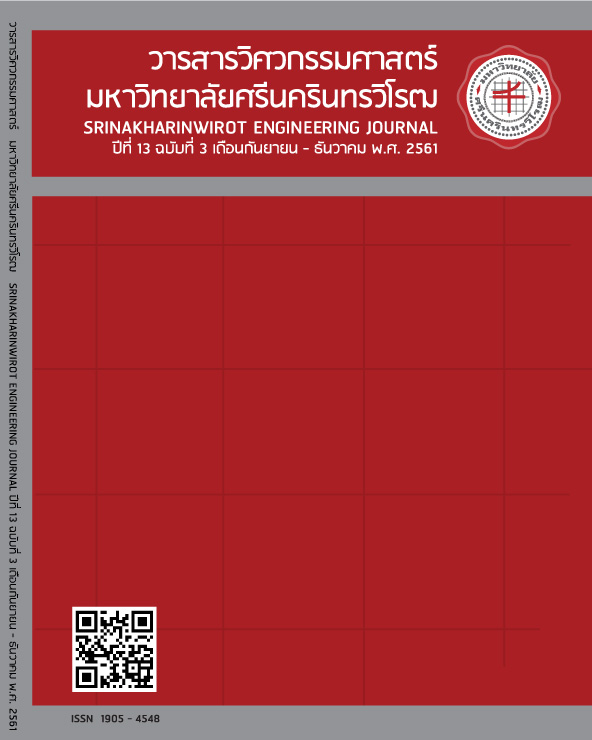Wind Turbine Generator with Maximum Power Point Tracking Using Wind form Evaporative Cooling System
Main Article Content
Abstract
The paper presents a wind power generator from an evaporative cooling system by wind turbine generator system. Generally, the output power of wind turbines extracted from wind energy depends on wind speed in which the characteristic is non-linear. Only one operating point providing the maximum power is available. Therefore, the maximum power point tracking control is important. The proposed technique will show that the maximum power can be obtained. The simulation and experiment are used to study and develop the maximum power point tracking algorithm. Hardware experimental results from prototype are presented to verify performance of the proposed power generation from evaporative cooling system.
Article Details
Copyright belongs to Srinakharinwirot University Engineering Journal
References
[2] S. Lalouni, D. Rekioua, K. Idjdarene and A. Tounzi, “Maximum Power Point Tracking Based Hybrid Hill-climb Search Method Applied to Wind Energy Conversion System,” Electric Power Components and Systems, Vol. 43, Issue. 8, pp. 1028-1038, Nov 2015.
[3] E. Koutroulis and K. Kalaitzakis, “Design of a maximum power tracking system for wind-energy-conversion applications,”IEEE Transactions on Industrial Electronics, Vol. 53, Issue. 2, pp. 486–494, April 2006.
[4] R. Kot, M. Rolak and M. Malinowski, “Comparison of maximum peak power tracking algorithms for a small wind turbine,” Mathematics and Computers in Simulation, Vol. 91, pp. 29–40, May 2013.
[5] K-H. Kim, T. Van, D-C. Lee, S-H. Song and E. Kim, “Maximum Output Power Tracking Control in Variable-Speed Wind Turbine Systems Considering Rotor Inertial Power,” IEEE Transactions on industrial Electronics, Vol. 60, Issue. 8, pp. 3207-3217, Aug 2013.
[6] O. Carranzaa, E. Figueresb, G. Garceráb and L. G. Gonzalezc, “Comparative study of speed estimators with highly noisy measurement signals for Wind Energy Generation Systems,” Applied Energy, Vol. 88, Issue. 3, pp. 805–813, March 2011.
[7] S. Muhammad, R. Kazmi, H. Goto, H.-J. Guo and O. Ichinokura, “A Novel Algorithm for Fast and Efficient Speed-Sensorless Maximum Power Point Tracking in Wind Energy Conversion Systems,” IEEE Transactions on Industrial Electronics, Vol. 58, Issue. 1, pp. 29 – 36, Jan 2011.
[8] L.G. Gonzáleza, E. Figueresb, G. Garceráb and O. Carranzac, “Maximum-power-point tracking with reduced mechanical stress applied to wind-energy-conversion-systems,” Applied Energy, Vol. 87, Issue. 7, pp. 2304–2312, July 2010.
[9] Y. Xia, K. H. Ahmed and B. W. Williams, “Wind Turbine Power Coefficient Analysis of a New Maximum Power Point Tracking Technique,” IEEE Transactions on Industrial Electronics, Vol. 60, Issue. 3, pp. 1122–1132, March 2013.
[10] Z. M. Dalala, Z. U. Zahid, W. Yu, Y. Cho and J.-S. (Jason). Lai, “Design and Analysis of an MPPT Technique for Small-Scale Wind Energy Conversion Systems,” IEEE Transactions on Energy Conversion, Vol. 28, Issue. 3, pp. 756–767, Sept 2013.
[11] Y. Dailia, J.-P. Gaubertb and L. Rahmania, “Implementation of a new maximum power point tracking control strategy for small wind energy conversion systems without mechanical sensors,” Energy Conversion and Management, Vol. 97, pp. 298–306, June 2015.
[12] Q.-N. Trinh and H.-H. Lee, “Fuzzy Logic Controller for Maximum Power Tracking in PMSG-Based Wind Power Systems,” Advanced Intelligent Computing Theories and Applications. With Aspects of Artificial Intelligence, Springer, pp. 543-553, 2010.
[13] J. Lee and Y.-S. Kim, “Sensorless fuzzy-logic-based maximum power point tracking control for a small-scale wind power generation systems with a switched-mode rectifier,” IET Renewable Power Generation, 10, Issue 2, pp. 194 –202, Feb 2016.

